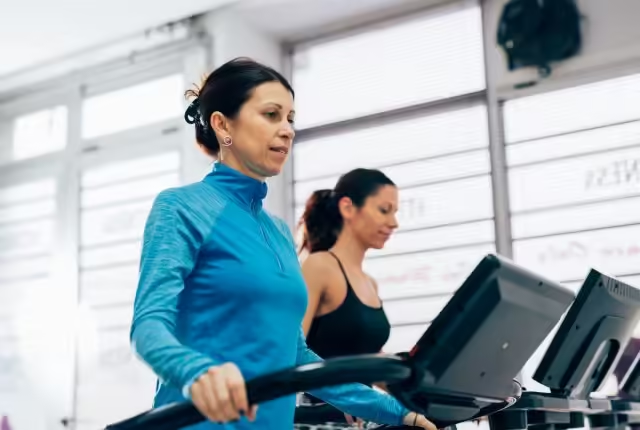Treadmill walking is a convenient way to keep moving throughout the year, regardless of the weather. You can simply put on your shoes, step onto the treadmill, and start walking to reach your step goals. Despite its ease of use, there are important guidelines to follow when using a treadmill. To help you maximize the benefits of your cardio workout, we talked to a fitness expert who identifies eight common errors to steer clear of during treadmill walking.
There are 2 paragraphs in the content.
Walking on a treadmill is an excellent way to boost your endurance and cardiovascular fitness. It’s also a great tool for burning calories and achieving your weight-loss goals. That being said, making certain common mistakes can create unwelcome setbacks and even result in injury. It all comes down to using proper form.
“Poor form can lead to injury,” stresses Ellen Thompson, CPT, Blink Fitness. “Proper alignment reduces stress on joints and muscles and, therefore, decreases the risk of injury. Proper form improves breathing; standing upright allows for better lung expansion and ensures you [get] enough oxygen during your workout.”
In addition, maintaining proper form and posture activates the muscles in your core, which, in turn, prevents slouching. This also helps improve stability and balance, further reducing your injury risk.
Now, let’s dive into the most common mistakes to avoid when treadmill walking and why they’re major no-nos, according to Thompson.
Holding onto the handrails
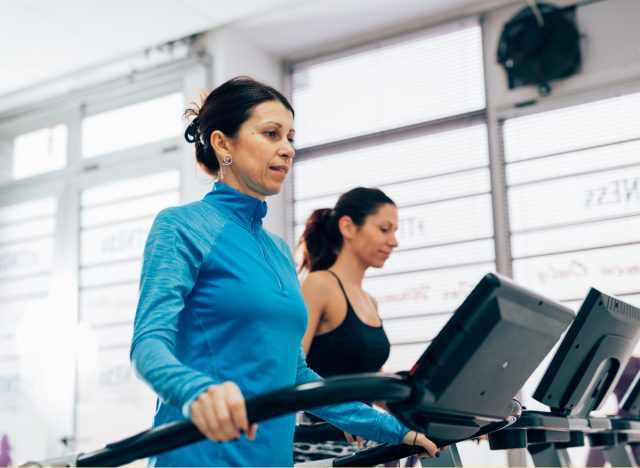

Holding onto the treadmill handrails may seem like a smart way to establish better stability and balance; however, it can ruin your cardio session.
“Holding onto [the] handrails reduces the effectiveness of your workout because it decreases the natural engagement of your muscles (specifically your core and legs), Thompson explains. “It adds an outside factor that isn’t necessarily helpful.”
Not using a natural arm swing
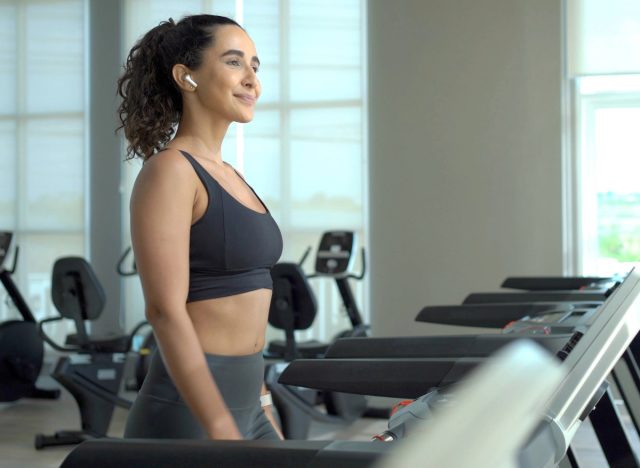

Another common error that’s deterring your progress is not using a natural arm swing. By keeping your arms at your sides, you’re not engaging your upper body and turning your treadmill time into a total-body workout.
“[In addition,] failing to move your arms naturally can throw off your balance and decrease the effectiveness of your workout,” says Thompson. “Use your arms for a natural swing. This will keep your walking motion smooth and allow you to maintain proper balance.”
Overstriding
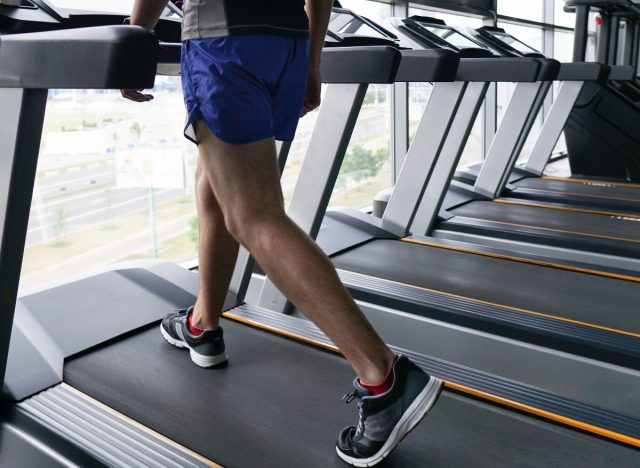

Overstriding means taking steps that are too big. This can lead to injury or place undue strain on your hips, knees, and lower back. “[Overstriding] also disrupts your natural walking pattern, which can lead to shin splints and other potential injuries,” Thompson points out.
Walking too fast or too slow
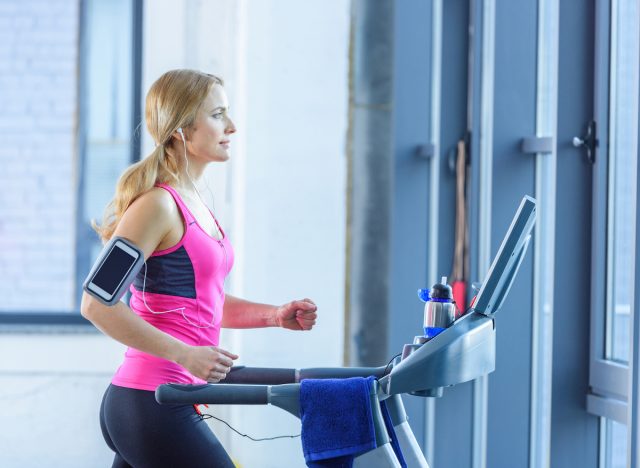

Being mindful of your walking pace is essential. “Walking too fast can cause you to lose control, leading to falls or muscle strains,” Thompson says. “Walking too slow might not give you the benefits you aim for.” For instance, walking at a very slow pace may not present enough of a challenge for your cardiovascular system, resulting in far fewer calories burned.
“Don’t walk too fast, too slow, too long, or too short,” Thompson encourages. “A natural stride is the most comfortable and will lead to the most effective workout.”
Leaning forward


Leaning too far forward when walking on a treadmill can disrupt your posture and result in discomfort or injury. “This goes against proper form and can put unnecessary strain on the lower back,” Thompson explains.
Make it your goal to stand tall while keeping your shoulders back and your abs activated. Maintaining an upright posture is the name of the game, as it helps decrease strain on your body and gives you an all-around more productive treadmill session.
Not making use of the incline settings
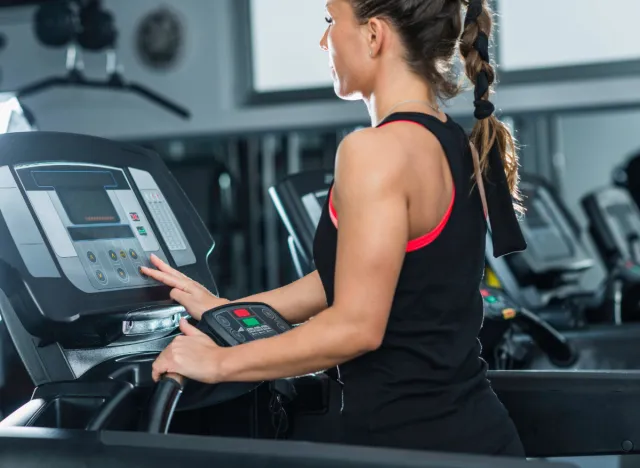

You’re doing yourself a major disservice by not utilizing the treadmill incline settings. “Walking on a flat surface doesn’t challenge your muscles or as much as walking on an incline does,” Thompson explains.
Incorporating inclines into your workout engages more muscle groups and adds an invigorating intensity that helps you progress. It’s an excellent way to take your workout to the next level without needing to adjust the speed very much.
Looking down
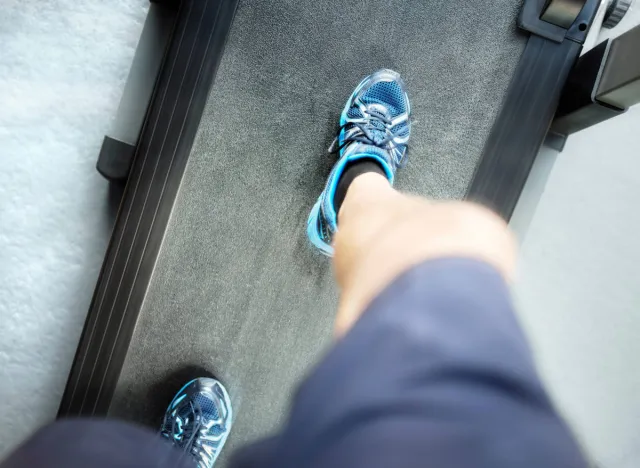

It may be a natural reaction to look down at your feet when treadmill walking, but try to avoid this. When looking down, you may assume a hunched posture, which can strain your neck. “It also throws off your balance, making you more prone to misstepping,” Thompson adds.
Wearing the wrong footwear
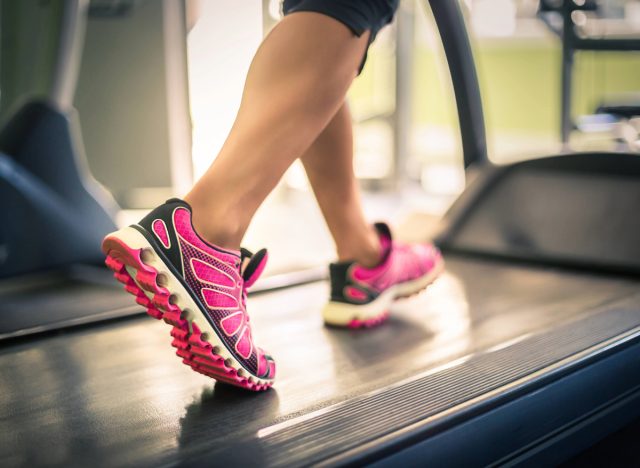

Being equipped with the proper footwear is essential to walking success. “Proper footwear is key! Shoes that don’t provide proper support or cushioning can lead to injury, blisters, and other foot-related injuries,” Thompson explains.
The right walking shoes should be supportive, breathable, durable, and the perfect fit.
Frequently Asked Questions (FAQs) About Treadmill Walking Mistakes
What are some common mistakes to avoid when treadmill walking?
When it comes to treadmill walking, there are several common mistakes that people often make. Some of the key errors to avoid include:
- Setting the incline too high
- Leaning too much on the handrails
- Wrong walking or running posture
- Using improper footwear
- Not staying hydrated
- Incorrect speed settings
- Skipping warm-up and cool-down
- Ignoring pain or discomfort
How do I avoid setting the incline too high?
To avoid setting the incline too high on the treadmill, start with a low incline setting and gradually increase it as you build up your strength and endurance. A good rule of thumb is to set the incline at no more than 1–2% for walking to simulate outdoor conditions without straining your muscles too much.
Why is leaning too much on the handrails a mistake during treadmill walking?
Leaning too much on the handrails while walking on the treadmill can compromise your posture and reduce the effectiveness of the workout. It can also put unnecessary strain on your upper body and affect your balance. To correct this mistake, focus on walking with a natural stride and posture without relying heavily on the handrails for support.
What is the importance of using proper footwear for treadmill walking?
Using proper footwear for treadmill walking is crucial to prevent injuries and ensure comfort during your workout. Invest in good-quality athletic shoes with proper cushioning and arch support to protect your feet, ankles, and knees from the impact of walking on the treadmill. Ill-fitting or worn-out shoes can lead to pain and discomfort.
How can I ensure I am staying hydrated during treadmill walking?
Staying hydrated during treadmill walking is essential for maintaining performance and preventing dehydration. Make sure to drink an adequate amount of water before, during, and after your workout. Keep a water bottle nearby or use the treadmill’s cup holders to sip water regularly. Signs of dehydration include dry mouth, fatigue, and dizziness.
What should I do if I feel pain or discomfort while treadmill walking?
If you experience pain or discomfort while treadmill walking, it is essential to stop immediately and assess the situation. Continuing to exercise through pain can lead to injuries. Try to identify the source of the pain, whether it’s due to improper footwear, muscle strain, or overexertion. If the pain persists, consult a healthcare professional for guidance.

